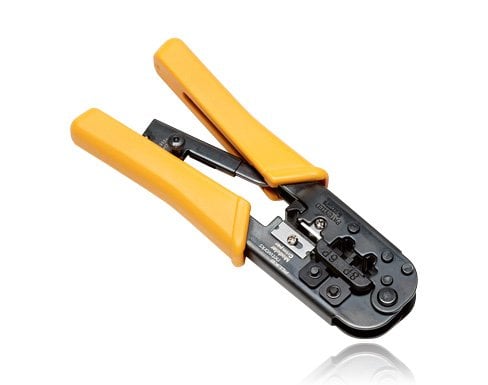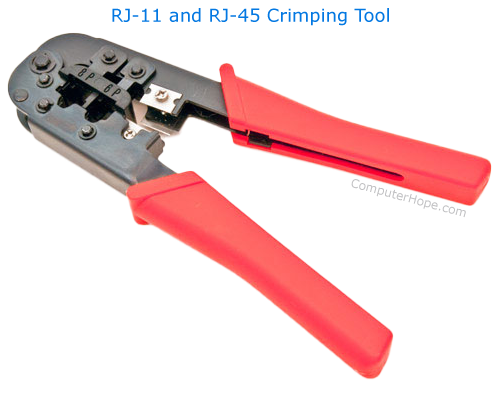Have you ever wondered how cables and connectors join so securely without any loose ends? The answer lies in a simple yet powerful device called a crimping tool.
Whether you’re fixing your home network, working on electronics, or tackling DIY projects, understanding what a crimping tool is can save you time and frustration. You’ll discover exactly how this tool works, why it’s essential, and how it can make your tasks easier and more reliable.
Keep reading to unlock the secrets behind perfect connections every time.

Credit: en.wikipedia.org
Crimping Tool Basics
Crimping tools are essential for many electrical and wiring tasks. They help join wires and connectors securely. Using the right tool ensures strong and lasting connections. Understanding how these tools work makes your projects easier and safer.
What Is A Crimping Tool
A crimping tool is a hand-held device. It joins two pieces of metal or wire by pressing them together. It is mostly used to attach connectors to cables. This process creates a tight bond without soldering or twisting.
Electricians and hobbyists often use crimping tools. They work with different types of connectors and wires. The tool’s shape and size depend on the job and materials involved.
How Crimping Tools Work
Crimping tools work by applying pressure to a connector and wire. The tool’s jaws close around the connector. This action squeezes the metal parts tightly together.
The pressure deforms the connector, making it grip the wire firmly. This secure connection allows electricity or signals to pass without interruption. Proper use prevents loose or weak joints that can cause problems.
Types Of Crimping Tools
Crimping tools come in different types to suit various tasks. Each type offers unique features and benefits. Choosing the right crimper depends on the job size and complexity. Understanding these types helps you pick the best tool for your needs.
Manual Crimpers
Manual crimpers are simple and easy to use. They work by squeezing handles to join connectors and wires. These tools are perfect for small tasks and light cables. Manual crimpers require physical effort but offer good control. They are affordable and widely available.
Hydraulic Crimpers
Hydraulic crimpers use fluid pressure for strong crimps. They handle larger cables and heavy-duty connectors easily. These tools reduce manual effort and increase power. Hydraulic crimpers are common in industrial and electrical work. They provide precise and consistent crimps every time.
Battery-powered Crimpers
Battery-powered crimpers combine power and portability. They use rechargeable batteries to drive the crimping action. These tools speed up work and reduce fatigue. Battery crimpers are ideal for fieldwork and frequent use. They balance ease of use with strong performance.
Common Uses
Crimping tools serve many purposes in different fields. They help join wires and connectors securely. Their use improves safety and performance in many tasks. Below are some common uses of crimping tools.
Electrical Wiring
Crimping tools connect wires to terminals in electrical systems. They ensure a strong and stable connection. This prevents loose wires and reduces electrical faults. Electricians use crimping tools often for home and industrial wiring.
Networking Cables
Networking cables need precise connections for fast data transfer. Crimping tools attach connectors to Ethernet cables. This makes sure the network works smoothly. They are essential for setting up internet and phone lines.
Automotive Applications
Cars have many electrical parts requiring secure connections. Crimping tools join wires in car wiring harnesses. They help maintain reliable circuits for lights, sensors, and more. Mechanics use crimping tools to fix or install car electronics.
Jewelry Making
Crimping tools shape metal beads and wires in jewelry. They fasten clasps or create decorative effects. Jewelers use them to secure parts without soldering. This technique saves time and keeps designs neat.

Credit: www.amazon.com
Benefits Of Crimping Tools
Crimping tools offer many benefits for both professionals and DIY enthusiasts. They make connecting wires and cables easier and more reliable. Using the right tool helps ensure strong and long-lasting links in electrical work.
Secure Connections
Crimping tools create tight and firm connections. They prevent wires from slipping out or getting loose. This reduces the risk of electrical faults and failures. The connections made with crimping tools are stable and durable.
Time Efficiency
Using a crimping tool speeds up the process of joining wires. It takes less time than soldering or twisting wires together. This helps finish projects faster. Quick connections mean less downtime and more productivity.
Cost-effectiveness
Crimping tools save money by reducing the need for repairs. Strong connections mean fewer problems in the future. They also lower material waste. Good tools reduce the chance of damaging cables or connectors.
Improved Safety
Crimping tools reduce the risk of electrical hazards. Secure connections prevent sparks and short circuits. They also help avoid overheating in wires. Using crimping tools leads to safer electrical systems overall.
Choosing The Right Crimping Tool
Choosing the right crimping tool is key to successful wiring and connections. The right tool makes your work easier and ensures strong, reliable crimps. Different tools suit different tasks. Consider important factors before buying a crimping tool.
Material Compatibility
Check the materials you will work with. Some crimping tools fit only copper wires. Others handle aluminum or steel. Using the correct tool avoids damage and weak crimps. Always match the tool to your wire material for best results.
Connector Types
Identify the connectors you use often. Some tools work with insulated terminals, non-insulated terminals, or coaxial connectors. Choose a tool that fits your connector types. This ensures a perfect fit and strong connection every time.
Tool Durability
Look for tools made from strong materials like steel. Durable tools last longer and resist wear. Check if the tool has rust-resistant coating. A sturdy tool saves money over time because it needs fewer replacements.
Budget Considerations
Set a budget before shopping. Basic tools cost less but may lack some features. Higher-priced tools offer better comfort and precision. Balance your needs and budget. Invest wisely to get good quality without overspending.

Credit: www.flukenetworks.com
Maintenance Tips
Proper maintenance of your crimping tool ensures it works well for a long time. Regular care keeps the tool safe and efficient. It helps avoid damage and costly repairs. Follow these simple tips to keep your tool in top shape.
Cleaning And Lubrication
Clean your crimping tool after every use. Remove dirt and dust with a soft cloth. Use a small brush to clear tight spots. Avoid using water to prevent rust. Apply a drop of light machine oil on moving parts. This keeps the tool smooth and easy to use.
Storage Practices
Store the tool in a dry place to avoid rust. Use a protective case or pouch if available. Keep it away from direct sunlight and moisture. Do not leave the tool on the floor or in dirty areas. Proper storage stops damage and keeps the tool ready for use.
Regular Inspection
Check your tool before each use. Look for cracks, rust, or loose parts. Test the handles and jaws for smooth movement. Tighten any loose screws carefully. Early detection of problems prevents bigger issues later on.
Frequently Asked Questions
What Is A Crimping Tool Used For?
A crimping tool connects wires and terminals securely. It compresses connectors onto cables for stable electrical connections. It is essential in wiring, networking, and electronics projects.
How Does A Crimping Tool Work?
A crimping tool applies pressure to connectors and wires. It deforms the connector to fit tightly around the wire. This creates a durable and reliable electrical joint without soldering.
What Types Of Crimping Tools Exist?
Common types include manual, ratchet, and hydraulic crimping tools. Each type suits different wire sizes and connector types. Choose based on your project’s requirements and complexity.
Can Crimping Tools Be Used For Networking Cables?
Yes, crimping tools are crucial for networking cables. They attach RJ45 connectors to Ethernet cables. This ensures proper data transmission and network reliability.
Conclusion
A crimping tool helps join wires and connectors tightly. It makes electrical and network work easier and safer. Using the right tool prevents loose connections and signal loss. Everyone working with cables benefits from knowing how to crimp properly. This simple tool saves time and improves project quality.
Understanding crimping tools adds value to your DIY or professional tasks. Give it a try to see the difference yourself.


